Immunostimulants or immune stimulants are drugs that energize the immune system when it is exhausted from fighting prolonged invasion or when the immune system needs help fighting a specific pathogen or cancer cell. It is one of the classifications of drug class called immunomodulators.
Immunomodulators, as the name implies, are drugs that modify the actions of the immune system. The other classification is immune suppressants, drugs utilized to block the normal effects of the immune system in cases of organ transplantation and autoimmune disorders.
Immune stimulants include interferons, interleukins, and colony-stimulating factors (utilized to stimulate bone marrow to produce more white blood cells especially for patients at serious risk for infection).
Table of Contents
- Immunostimulants: Generic and Brand Names
- Interferons
- Interleukins
- Colony-Stimulating Factors
- Nursing Considerations
- Practice Quiz: Immune Stimulants
- Recommended Resources
- See Also
- References and Sources
Immunostimulants: Generic and Brand Names
Here is a table of commonly encountered immune stimulants, their generic names, and brand names:
- Interferons
- interferon-alpha-2b (Intron-A)
- interferon-alfacon-1 (Infergen)
- interferon-alfa-n3 (Alferon N)
- interferon-beta-1a (Avonex)
- interferon-beta-1b (Betaseron)
- interferon-gamma-1b (Actimmune)
- peginterferon alfa-2b (Peg-Intron)
- Interleukins
- aldesleukin (Proleukin)
- oprelvekin (Neumega)
- Colony-Stimulating Factors
- filgrastim (Neupogen)
- pegfilgrastim (Neulasta)
- sargramostim (Leukine)
Interferons
- Interferons are substances naturally produced and released by human cells that have been invaded by the viruses. They may also be released from cells in response to other stimuli, e.g. cytotoxic T-cell activity.
- Through the advent of recombinant DNA technology, a number of interferons are now available for use.
Therapeutic Action
The desired and beneficial actions of interferons are as follows:
- Preventing virus particles from replicating inside cells.
- Stimulating interferon receptor sites on non invaded cells to produce antiviral proteins, which prevent viruses from entering the cell.
- Others include inhibiting tumor growth and replication, stimulating cytotoxic T-cell activity, and enhancing inflammatory response.
- Interferon gamma-1b also acts like an interleukin, stimulating phagocytes to be more aggressive.
Indications
Interferons are indicated for the following medical conditions:
- Treatment of chronic hepatitis C in adults
- Treatment of multiple sclerosis in adults
- Treatment of leukemias, Kaposi sarcoma, warts, AIDS-related complex, and malignant melanoma
Here are some important aspects to remember for indication of immune modulators in different age groups:
Children
- Most immune modulators are not recommended for use in children or have not been tested.
- Exceptions include interferon alfa-2b, azathioprine, cyclosporine, tacrolimus, and palivizumab which should be used cautiously because of their toxic effects on GI, renal, hematological, or central nervous system.
- Active children should be protected from infection and injury.
Adults
- Emphasize the importance of avoiding exposure to infection. Regular follow-up and medical care should be stressed.
- Educate about proper technique for injection, disposal of needles, and special storage precautions for the drug.
- Immune modulators are contraindicated for pregnancy and lactation because of potential adverse effects to neonate or fetus (e.g. fetal abnormalities, increased maternal and fetal abnormalities, and increased maternal and fetal infections, suppressed immune responses in nursing babies).
- Women of childbearing age should be advised to use barrier contraceptives while taking these drugs. Some drugs may also impair fertility.
Older adults
- The aging immune system of this population makes them more susceptible to the effects of immunomodulators.
- Monitor closely for GI, CNS, renal, and hepatic toxic effects.
- Extensive health education on avoiding infection and injury is necessary.
Pharmacokinetics
Here are the characteristic interactions of interferons and the body in terms of absorption, distribution, metabolism, and excretion:
| Route | Onset | Peak | Duration |
| IM, subcutaneous | Rapid | 3-12 h | – |
| IV | Rapid | End of infusion | – |
| T1/2: 2-3 h Metabolism: kidney Excretion: unknown |
Contraindications and Cautions
The following are contraindications and cautions for the use of interferons:
- Allergy to any interferons or product component. Prevent hypersensitivity reaction.
- Pregnancy and lactation. Potential adverse effects on the neonate or mother.
- Cardiac disease. Hypertension and arrhythmias have been reported with the use of these drugs.
- Myelosuppression. These drugs may suppress the bone marrow.
- Central nervous system (CNS) dysfunction of any kind. Potential for CNS depression and personality changes have been reported.
Adverse Effects
Use of interferons may result to these adverse effects:
- Flu-like syndrome: lethargy, myalgia, arthralgia, anorexia, nausea
- CNS: headache, dizziness, bone marrow depression, depression and suicidal ideation
- GI: liver impairment
- Others: photosensitivity
Interactions
There are no reported clinically important drug-drug interactions with interferons.
Interleukins
- Interleukins are synthetic compounds that communicate between lymphocytes, thereby stimulating cellular immunity and inhibiting tumor growth.
- Interleukin-2 stimulates cellular immunity by increasing the activity of natural killer cells, platelets, and cytokines.
Therapeutic Action
The desired and beneficial actions of interleukins are as follows:
- Increasing the number of natural killer cells and lymphocytes, cytokine activity, and circulating platelets.
Indications
Interleukins are indicated for the following medical conditions:
- Treatment of specific renal carcinomas in adults
- Prevention of severe thrombocytopenia
Pharmacokinetics
Here are the characteristic interactions of interleukins and the body in terms of absorption, distribution, metabolism, and excretion:
| Route | Onset | Peak | Duration |
| IV | 5 min | 13 min | 3-4 h |
| T1/2: 85 min Metabolism: kidney Excretion: urine |
Contraindications and Cautions
The following are contraindications and cautions for the use of interleukins:
- Allergy to any interleukins or E-coli-produced product. To prevent hypersensitivity reactions.
- Pregnancy. These drugs were shown to be embryocidal and teratogenic in animal studies.
- Lactation. Potential adverse effects to the baby as it is not clear whether drugs can cross into breast milk.
- Renal, liver, cardiovascular impairment. Adverse effects of the drug.
Adverse Effects
Use of interleukins may result to these adverse effects:
- Flu-like effects: lethargy, myalgia, arthralgia, fatigue, fever
- CNS changes
- Respiratory difficulties
- Cardiac arrhythmia
- Oprelvekin has been associated with severe hypersensitivity reactions, and patients should be instructed to report difficulty breathing or swallowing, chest tightness, or swelling.
Interactions
There are no reported clinically important drug-drug interactions with interleukins.
Colony-Stimulating Factors
- Colony-stimulating factors are produced by recombinant DNA technology.
- These drugs can increase production of neutrophils and can activate mature granulocytes and monocytes.
Therapeutic Action
The desired and beneficial action of colony-stimulating factors is:
- Increasing the production of white cells.
Indications
Colony-stimulating factors are indicated for the following medical conditions:
- Reduction of incidence of infection in patients with bone marrow suppression
- Decrease in neutropenia associated with bone marrow transplants and chemotherapy
- Treatment of various blood-related cancers
Pharmacokinetics
Here are the characteristic interactions of colony-stimulating factors and the body in terms of absorption, distribution, metabolism, and excretion:
| Route | Onset | Peak | Duration |
| IV | – | 2 h | 4 d |
| Subcutaneous | – | 8 h | 4 d |
| T1/2: 210-231 minutes Metabolism: unknown Excretion: unknown |
Contraindications and Cautions
The following are contraindications and cautions for the use of colony-stimulating factors
- Allergy to any interleukins or E-coli-produced product. To prevent hypersensitivity reactions.
- Sargramostim is contraindicated in neonates because of benzyl alcohol in the solution and with excessive leukemoid myeloid blasts in the bone marrow or peripheral blood which could be worsened by the drug. Caution is also used in patients with hepatic or renal failure which could alter the pharmacokinetics of the drug.
- Pregnancy and lactation. Effects on the fetus or neonate are not known.
Adverse Effects
Use of colony-stimulating factors may result to these adverse effects:
- CNS: headache, fatigue, generalized weakness
- GI: nausea, vomiting, diarrhea, constipation, anorexia
- Skin: alopecia, dermatitis
- Musculoskeletal: generalized pain, bone pain
Interactions
These drugs have drug-drug interactions with:
- Lithium or corticosteroids. Sargramostim’s increase in myeloproliferative effects.
Nursing Considerations
Here are important nursing considerations when administering immune stimulants:
Nursing Assessment
These are the important things the nurse should include in conducting assessment, history taking, and examination:
- Assess for contraindications or cautions (e.g. history of allergy to the drug, pregnancy and lactating status, hepatic, renal, or cardiac disease, leukemic states, etc.) to avoid adverse effects.
- Establish baseline physical assessment to monitor for any potential adverse effects.
- Assess for presence of skin lesions to detect early dermatological effects.
- Obtain weight to monitor for fluid retention.
- Monitor temperature to detect any infection.
- Evaluate CNS status to assess CNS effects of the drug.
- Monitor laboratory tests like CBC and renal and liver function to determine the need for possible dose adjustment and to identify changes in bone marrow function.
Nursing Diagnoses
Here are some of the nursing diagnoses that can be formulated in the use of these drugs for therapy:
- Acute pain related to CNS, GI and flu-like effects
- Imbalanced nutrition: less than body requirements related to flu-like effects
- Anxiety related to diagnosis and drug therapy
Implementation with Rationale
These are vital nursing interventions done in patients who are taking immune stimulants:
- Arrange for laboratory tests before and periodically during therapy, including CBC and differential, to monitor for drug effects and adverse effects.
- Monitor for severe reactions, such as hypersensitivity reactions, and arrange to discontinue the drug immediately if they occur.
- Administer drug as indicated; instruct patient and significant other if injections are required to ensure that the drug will be given if the patient is not able to administer it.
- Arrange for supportive care and comfort measures (e.g. rest, environmental control) to help patient cope with drug effects.
- Provide patient education about drug effects and warning signs to increase knowledge about drug therapy and to increase compliance with drug.
Evaluation
Here are aspects of care that should be evaluated to determine effectiveness of drug therapy:
- Monitor patient response to therapy (improvement in condition being treated).
- Monitor for adverse effects (e.g. flu-like symptoms, GI upset, CNS changes, bone marrow depression).
- Evaluate patient understanding on drug therapy by asking patient to name the drug, its indication, and adverse effects to watch for.
- Monitor patient compliance to drug therapy.
Practice Quiz: Immune Stimulants
Here are some practice questions for this study guide. Please visit our nursing test bank page for more NCLEX practice questions.
1. This is a substance released from cells in response to cytotoxic T-cell activity.
A. Interferons
B. Interleukins
C. Colony-stimulating factor
D. Monoclonal antibody
1. Answer: A. Interferons
Interferons are substances naturally-produced and released by human cells that have been invaded by the viruses. It can be released from cells in response to other stimuli, such as cytotoxic T-cell activity.
2. How do interleukins exert its therapeutic benefits inside the body?
A. By preventing viral replication inside cells
B. By inhibiting tumor growth and replication
C. By increasing the number of natural killer cells and lymphocytes
D. By producing antiviral proteins
2. Answer: C. By increasing the number of natural killer cells and lymphocytes
All other options are actions of interferons.
3. All of the following are not true about immune modulators, except:
A. Most can be safely recommended in children.
B. Infection control is an integral part of drug therapy.
C. Interferons and interleukins have many drug-to-drug interactions.
D. None of the above
3. Answer: B. Infection control is an integral part of drug therapy.
Patients on immune modulator therapy should be protected from injury and infection. Regular follow-up and medical care should be stressed.
4. All of the following complaints will alert the nurse of colony stimulating factor adverse effect, except:
A. alopecia
B. generalized weakness
C. coughing
D. vomiting
4. Answer: C. coughing
Other adverse effects include bone pain, GI upset, dermatitis, and fatigue.
5. Which immune stimulant is usually used for treatment of blood-related cancers?
A. interferons
B. interleukins
C. colony-stimulating factors
D. all of the above
5. Answer: C. colony-stimulating factors
Interferons are usually indicated for hepatitis C, Kaposi sarcoma, and AIDS-related complex. Interleukins are usually for renal carcinomas and severe thrombocytopenia.
Recommended Resources
Our recommended nursing pharmacology resources and books:
Disclosure: Included below are affiliate links from Amazon at no additional cost from you. We may earn a small commission from your purchase which will help support us. Thank you! For more information, check out our privacy policy.
Pharm Phlash! Pharmacology Flash Cards #1 BEST SELLER!
Test-yourself review cards put critical clinical information for nearly 400 of the top generic medications at your fingertips. And, you can count on them for accuracy, because each card is based on content from Davis’s Drug Guide for Nurses. Increase your test scores in pharmacology class.
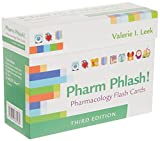
Focus on Pharmacology (8th Edition)
Focus on Nursing Pharmacology makes challenging concepts more approachable. Engaging learning features cultivate your clinical application, critical thinking and patient education capabilities. This updated 8th edition builds on your knowledge of physiology, chemistry and nursing fundamentals to help you conceptualize need-to-know information about each group of drugs.
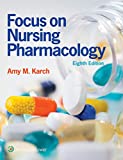
Pharmacology Made Incredibly Easy (Incredibly Easy! Series®)
Nursing pharmacology guide offers step-by-step guidance so you can grasp the fundamentals in enjoyable Incredibly Easy style. This is the perfect supplement to class materials, offering solid preparation for NCLEX® as well as a handy refresher for experienced nurses. Colorfully illustrated chapters offer clear, concise descriptions of crucial nursing pharmacology concepts and procedures.
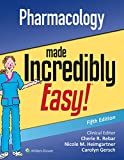
Lehne’s Pharmacology for Nursing Care (11th Edition)
The Eleventh Edition of Lehne’s Pharmacology for Nursing Care provides a thorough understanding of key drugs and their implications for nursing care. This text, written by renowned nursing educators, helps you comprehend and apply pharmacology principles. A clear and engaging writing style simplifies complex concepts, making even the most challenging pharmacology content enjoyable. We recommend this book if you want a comprehensive nursing pharmacology guide.
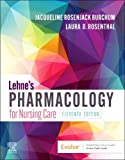
Nursing Drug Handbook
Nursing2023 Drug Handbook delivers evidence-based, nursing-focused drug monographs for nearly 3700 generic, brand-name, and combination drugs. With a tabbed, alphabetical organization and a “New Drugs” section, NDH2023 makes it easy to check drug facts on the spot.
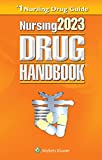
Pharmacology and the Nursing Process
The 10th edition of Pharmacology and the Nursing Process offers practical, user-friendly pharmacology information. The photo atlas contains over 100 unique illustrations and photographs depicting drug administration techniques. Updated drug content reflects the most recent FDA drug approvals, withdrawals, and therapeutic uses.
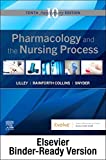
Mosby’s Pharmacology Memory NoteCards: Visual, Mnemonic, and Memory Aids for Nurses
The 6th edition of Mosby’s Pharmacology Memory NoteCards: Visual, Mnemonic, & Memory Aids for Nurses incorporates illustrations and humor to make studying easier and more enjoyable. This unique pharmacology review can be utilized as a spiral-bound notebook or as individual flashcards, making it ideal for mobile study.
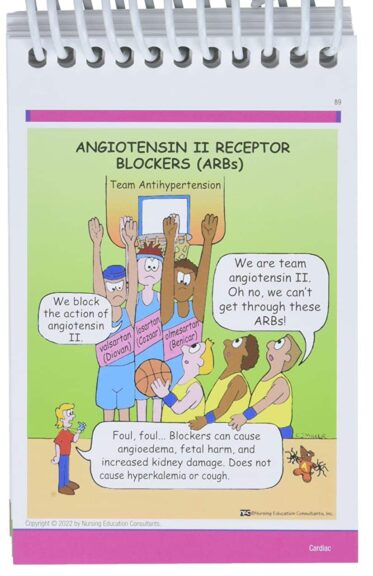
See Also
Here are other nursing pharmacology study guides:
- Nursing Pharmacology – Study Guide for Nurses
Our collection of topics related to nursing pharmacology - Pharmacology Nursing Mnemonics & Tips
These nursing mnemonics aim to simplify the concepts of pharmacology through the use of a simple, concise guide. - Generic Drug Name Stems Cheat Sheet
Learn about these generic drug name stems to help you make sense of drugs easier! - Common Drugs and Their Antidotes
A guide to drug antidotes that nurses should be familiar about. - IV Fluids and Solutions Guide & Cheat Sheet
Get to know the different types of intravenous solutions or IV fluids in this guide and cheat sheet. - Drug Dosage Calculations NCLEX Practice Questions (100+ Items)
Care to take the challenge? This quiz aims to help students and registered nurses alike grasp and master the concepts of medication calculation.
Drug Guides NEW!
Individual drug guides and nursing considerations for the most common medications used in nursing pharmacology:
- Acetaminophen (Tylenol)
- Aspirin
- Atorvastatin (Lipitor)
- Enoxaparin (Lovenox)
- Furosemide (Lasix)
- Gabapentin
- Hydromorphone (Dilaudid)
- Lisinopril
- Metoprolol
- Morphine
Gastrointestinal System Drugs
Respiratory System Drugs
- Antihistamines
- Bronchodilators and Antiasthmatics
- Decongestants
- Expectorants and Mucolytics
- Inhaled Steroids
- Lung Surfactants
Endocrine System Drugs
- Adrenocortical Agents
- Antidiabetic Agents
- Glucose-Elevating Agents
- Hypothalamic Agents
- Insulin
- Parathyroid Agents: Bisphosphonates, Calcitonins
- Pituitary Drugs
- Sulfonylureas
- Thyroid Agents
Autonomic Nervous System Drugs
- Adrenergic Agonists (Sympathomimetics)
- Adrenergic Antagonists (Sympatholytics)
- Anticholinergics (Parasympatholytics)
- Cholinergic Agonists (Parasympathomimetics)
Immune System Drugs
Chemotherapeutic Agents
- Anthelmintics
- Anti-Infective Drugs
- Antibiotics
- Antifungals
- Antineoplastic Agents
- Antiprotozoal Drugs
- Antiviral Drugs
Reproductive System Drugs
Nervous System Drugs
- Antidepressants
- Antiparkinsonism Drugs
- Antiseizure Drugs
- Anxiolytics and Hypnotic Drugs
- General and Local Anesthetics
- Muscle Relaxants
- Narcotics, Narcotic Agonists, and Antimigraine Agents
- Neuromuscular Junction Blocking Agents
- Psychotherapeutic Drugs
Cardiovascular System Drugs
References and Sources
References and sources for this pharmacology guide for Immunostimulants:
- Karch, A. M., & Karch. (2011). Focus on nursing pharmacology. Wolters Kluwer Health/Lippincott Williams & Wilkins. [Link]
- Katzung, B. G. (2017). Basic and clinical pharmacology. McGraw-Hill Education.
- Lehne, R. A., Moore, L. A., Crosby, L. J., & Hamilton, D. B. (2004). Pharmacology for nursing care.
- Smeltzer, S. C., & Bare, B. G. (1992). Brunner & Suddarth’s textbook of medical-surgical nursing. Philadelphia: JB Lippincott.
